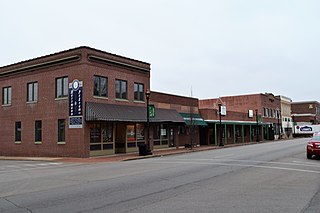
The East Columbia Historic District is a national historic district located at Farmington, St. Francois County, Missouri. The district encompasses 11 contributing buildings in the central business district of Farmington. It developed between about 1879 and 1954, and includes representative examples of Late Victorian, Beaux Arts, and Bungalow / American Craftsman style architecture. Notable buildings include the Tetley Jewelry Store, Andy Hahn Building, Lang and Holler Building, U.S. Post Office, and Henry C. Meyer Building, and T.F. Lockridge Harness Co. Building / Wichman Nash Service.

The Ozark Courthouse Square Historic District is a national historic district located at Ozark, Christian County, Missouri. It encompasses 19 contributing buildings in a 5.3-acre (2.1 ha) area in the central business district of Ozark. The central feature of the district, the Christian County Courthouse, is a three-story, Classical Revival style brick building designed by architect Henry H. Hohenschild. Other notable buildings include the Bank of Ozark/Masonic Lodge (1897), First Baptist Church (1919), Methodist Episcopal Church (1914), Robertson Brothers’ Store (1882), Ozark Drug (1905), Works Progress Administration Community Building (1934), Hospital, and Christian County Bank.

The Benton County Courthouse is a courthouse in Bentonville, Arkansas, United States, the county seat of Benton County, built in 1928. It was listed on the National Register of Historic Places in 1988. The courthouse was built in the Classic Revival style by Albert O. Clark and anchors the east side of the Bentonville Town Square.

Presbyterian Orphanage of Missouri, also known as Farmington Children's Home and Presbyterian Children's Home, is a historic orphanage and national historic district located at 412 West Liberty Street in Farmington, St. Francois County, Missouri. The district encompasses five contributing large brick buildings built between 1939 and the early 1950s in the Georgian Revival style. They are the Administration Building and Dining Hall, built in 1939 and enlarged in the 1940s, two large dormitories built in the early 1950s, and a smaller "hospital" building known as Holmes Cottage built in 1940. The Presbyterian Children's Home vacated the campus in 1999. The campus is currently an apartment complex for senior citizens.

Kokomo Courthouse Square Historic District is a national historic district located at Kokomo, Howard County, Indiana. The district includes 60 contributing buildings, 1 contributing structure, and 1 contributing object in the central business district of Kokomo. It developed between about 1870 and 1937 and includes notable examples of Italianate, Queen Anne, and Romanesque Revival style architecture. Notable buildings include the Draper Block (1904), Wilson Block, College Building (1909), Howard County Courthouse (1937), and a Railroad Watchman Tower.
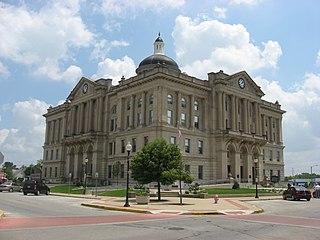
Huntington Courthouse Square Historic District is a national historic district located at Huntington, Huntington County, Indiana. The district includes 102 contributing buildings and 3 contributing structures in the central business district of Huntington. It developed between about 1845 and 1942 and includes notable examples of Italianate, Queen Anne style architecture in the United States, Romanesque Revival, Neoclassical, and Commercial style architecture. Located in the district are the separately listed Moore/Carlew Building and Hotel LaFontaine. Other notable buildings include the Hotel Huntington (1848), Opera House (1881), Lewis Block, Huntington County Courthouse (1904), old Post Office (1916), Citizens' State Bank, City Hall / Fire Station (1904), Huntington Light and Fuel Building, Our Sunday Visitor building (1926), YMCA (1929), and Huntington Theater.
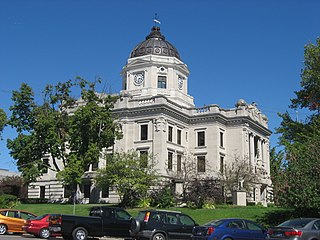
Courthouse Square Historic District is a national historic district located at Bloomington, Monroe County, Indiana. The district encompasses 57 contributing buildings in the central business district of Bloomington. It developed between about 1847 and 1936, and includes notable examples of Classical Revival, Beaux Arts and Italianate style architecture. Located in the district are the separately listed Bloomington City Hall, Monroe County Courthouse, Princess Theatre, and Wicks Building. Other notable buildings include the Federal Building, Masonic Temple, former Faulkner Hotel, Odd Fellows Building (1892), Allen Building (1907), First National Bank Building (1907), Knights of Pythias Building (1907), and Graham Hotel Building.

Kirksville Courthouse Square Historic District is a national historic district located at Kirksville, Adair County, Missouri. The district encompasses 10 contributing buildings and 2 contributing objects in the central business district of Kirksville. It developed between 1883 and 1925, and includes representative examples of Italianate, Romanesque Revival, and Classical Revival style architecture. Located in the district is the separately listed Adair County Courthouse. Other notable buildings include the Union Meat Market, Irwin Davis Sheet Metal Company, Baxter-Miller Apartment Building (1925), Ivie's Hotel (1883), and Pickler's Famous Store (1887).
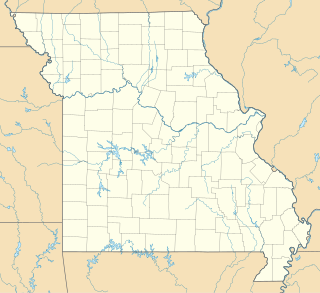
Harrisonville Courthouse Square Historic District is a national historic district located at Harrisonville, Cass County, Missouri. The district includes 34 contributing buildings, 1 contributing structure, and 1 contributing object in the central business district of Harrisonville. It developed between about 1880 and 1943, and includes representative examples of Italianate, Queen Anne, Colonial Revival, Tudor Revival, and Renaissance Revival style architecture. Notable buildings include the Cass County Courthouse (1897), New Method Laundry (1929), Cass County Democrat, Wooldridge Building, Bank of Harrisonville (1900-1901), Wirt's Opera House Building, Post Office Building (1925), Emmons Building/Bowman Building (1887), Evans Building (1890), White Motor Company, Stephen Stuart "Racket" Store, First National Bank of Harrisonville, and Deacon Building (1892).

South Liberty Courthouse Square Historic District is a national historic district located at Liberty, Clay County, Missouri. It encompasses nine contributing buildings in the central business district of Liberty. The district developed between about 1875 and 1942, and includes representative examples of Classical Revival, Late Victorian, and Modern Movement style architecture. Notable buildings include the Clay County Courthouse (1935-1936) by Wight and Wight and First National Bank (1923).
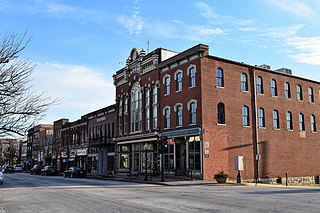
Missouri State Capitol Historic District is a national historic district located at Jefferson City, Cole County, Missouri. It encompasses 122 contributing buildings in the central business district of Jefferson City. The district developed between about 1850 and 1950, and includes representative examples of Classical Revival, Late Victorian, Queen Anne, Mission Revival, and Modern Movement style architecture. Located in the district are the separately listed Missouri State Capitol, Lohman's Landing Building, Cole County Historical Society Building, Cole County Courthouse and Jail-Sheriff's House, Missouri Governor's Mansion, and Tergin Apartment Building. Other notable buildings include the St. Peter's Roman Catholic Church complex (1881-1883), Margaret Upshulte House, Broadway State Office Building (1938), Supreme Court of Missouri (1905-1906), U.S. Post Office and Courthouse (1932-1934), Lohman's Opera House, Missouri State Optical, First United Methodist Church (1900), Carnegie Public Library (1901), Temple Beth El (1883), and Joseph and Susie Kolkmeyer House.

Clinton Square Historic District is a national historic district located at Clinton, Henry County, Missouri. The district encompasses 62 contributing buildings, 1 contributing structure, and 1 contributing object in the central business district of Clinton. It developed between about 1885 and 1957 and includes representative examples of Italianate and Romanesque Revival style architecture. Located in the district is the separately listed Anheuser-Busch Brewing Association Building. Other notable buildings include the Fristoes Body Shop Office, Whitehead Consultants, Texas Room / Pit Stop Pub, State Farm Insurance, Montgomery Ward (1940s), J.C. Penney / Brownsbergers / Eberting's Main Street Central, Old City Hall (1891), Delozier Building (1887), Crest Cinema, Henry County Courthouse, and the Bandstand on Courthouse Square.

Fayette Courthouse Square Historic District is a national historic district located at Fayette, Howard County, Missouri. The district encompasses 35 contributing buildings in the central business district of Fayette. It developed between about 1828 and 1947 and includes representative examples of Second Empire, Italianate, and Romanesque Revival style architecture. Located in the district is the separately listed Dr. Uriel S. Wright Office. Other notable buildings include the Fayette Public Library (1914), City Hall (1925), New Opera House Block (1903), A. F. Davis Bank, Commercial Bank (1910), The New Century Block Building (1902), Bell Block Building (1883), U.S. Post Office Building (1925), Howard County Jail and Residence, and Howard County Courthouse (1887).

Courthouse Square Historic District is a national historic district located at West Plains, Howell County, Missouri. The district encompasses 46 contributing buildings in the central business district of West Plains. It developed between about 1881 and 1950 and includes representative examples of Italianate, Queen Anne, Romanesque Revival, Late Gothic Revival, and Art Deco style architecture. Located in the district are the separately listed Elledge Arcade Buildings, W. J. and Ed Smith Building, and West Plains Bank Building. Other notable buildings include the IOOF Building #2, First Presbyterian Church, Howell County Courthouse (1937), Aid Hardware Building (1914-1915), W. N. Evans Building, J. R. Foster Building, Foster-Renfrew Building, Alsup, Risley & Skillman Block, Catron Opera House / Johnson Opera House (1893), IOOF Building / J. R. Galloway Building (1896), Evans Theatre, W. J. Zorn Building, #1/Howell County Gazette Building (1911-1912), West Plains Fire Department/City Hall (1917), and Avenue Theatre (1950).

Edina Double Square Historic District is a national historic district located at Edina, Knox County, Missouri. The district encompasses 37 contributing buildings in the central business district of Edina. It developed between about 1865 and 1945 and includes representative examples of Italianate and Streamline Moderne style architecture. Notable contributing buildings include the Public Works Administration funded Knox County Courthouse (1934–1935) designed by William B. Ittner, Bishoff Bakery (1891), Northern Hotel (1860s), Ennis House/Northern Hotel, Edina School and Gymnasium (1915–1916), D. H. Mudd Building, Phillip Linville Building, Tobias J. Lycan Building, Jacob Pugh Building, Albert G. Bostick Building, Knox County Savings Bank, Thomas Burk Buildings, Bank of Edina Building, Joseph F. Biggerstaff Buildings, Stablein Building, and Knox County Public Library.

Fredericktown Courthouse Square Historic District is a national historic district located at Fredericktown, Madison County, Missouri. The district encompasses 26 contributing buildings in the central business district of Fredericktown. It developed between about 1819 and 1958, and includes representative examples of Renaissance Revival, Italianate, and Art Deco style architecture. Located in the district is the separately listed Madison County Courthouse designed by Theodore Link. Other notable buildings include the Old Livery, I.O.O.F. Hall, Masonic Hall (1913), Madison Hotel, and Democrat News.
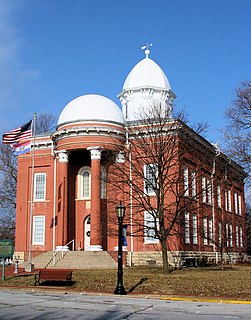
Moniteau County Courthouse Square is a national historic district located at California, Moniteau County, Missouri. The district encompasses 21 contributing buildings and 1 contributing site in the central business district of California. It developed between about 1867 and 1900, and includes representative examples of Classic Revival architecture. Contributing buildings include the Moniteau County Courthouse (1867-1868) and a variety of commercial buildings contemporary with the courthouse, dating from the mid to late-19th century.

St. Francois County Jail and Sheriff's Residence is a historic jail and sheriff's residence located at Farmington, St. Francois County, Missouri. It was built in 1870-1871, and is a two-story, three bay, Greek Revival style brick and limestone building. It has a front gable roof and centered arched front doorway. The building was enlarged slightly around 1909. By 1996, it was one of the oldest operating jails in Missouri, but it was retired in September of that year when the jail moved to a newer and larger facility. The building now serves as a low-cost inn for people traveling along the TransAmerica Bicycle Trail.

Henry H. Hohenschild, also known as H.H. Hohenschild, was an architect based in Rolla, Missouri, USA. He born at St. Louis, and educated in the city's public schools. He moved to Rolla in 1881, where he established an architectural practice designing public and residential buildings. He was elected to the Missouri Senate in 1896. In 1899 was appointed State Architect by Governor Lon V. Stephens which involved the architect in designing several state buildings including some at the state penitentiary. In addition to 10 county courthouses, he designed several buildings for the School of Mines, the State Mental Institution in Farmington (1901), the Tuberculosis Sanitarium in Mount Vernon, Missouri (1905), and the temporary state capitol building in Jefferson City in 1912. He died on February 3, 1928 in St. Louis from a heart condition.


























